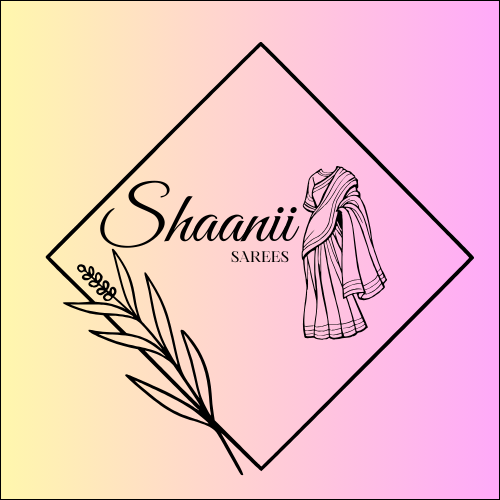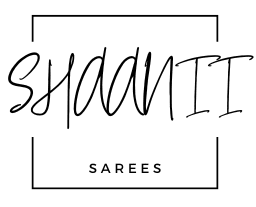9 Different Types of Sarees In India
India is a beautiful country, a perfect blend of numerous religions, 22 different languages and so many unique cultures. It originated its own style in the name of saree. Anywhere in the world if you see a woman wearing a saree it will only remind you of India. The start of journey of saree in India as old as our ancestors. It began with cotton sarees and then took many other forms. Here in this article we are sharing some amazingly woven Indian sarees. Let’s have a look of different types of sarees in India:
1. Banarasi Saree
Banaras is a city in India which instantly pops in our minds when someone talks about silk sarees. This city has best of its production when it comes to golden/silver zari or fine silk or embroidery. So many brides choose Banarasi saris for their bridal attire. Not only these are famous in India but also worldwide.
What makes it so distinctive is its intricate weaving designs using gold or silver zari with the help of hand-weaving techniques. Generally, it is made using 5600 thread wires. The lustre and shine on an authentic Banarasi saree are something one can never ignore. This is one of my favorites types of sarees
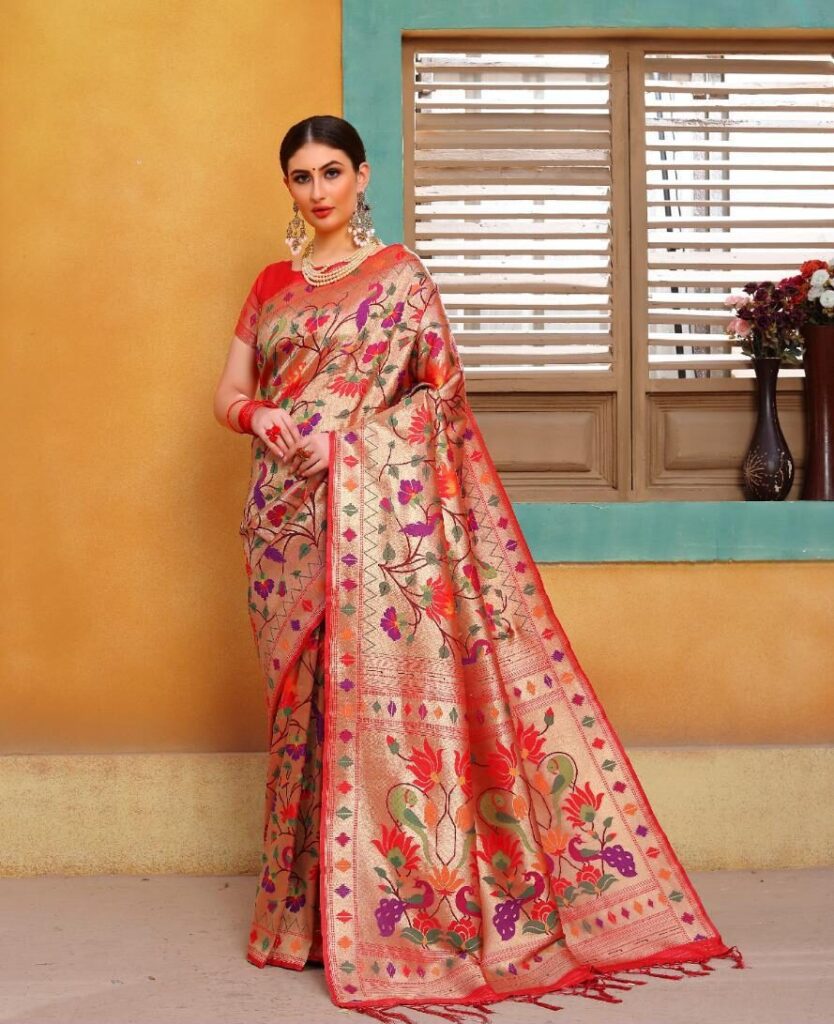

2. Chanderi Sari
Who doesn’t know about Madhya Pradesh? ‘The heart of India.’ The city originates a pearl known as “Chanderi Sarees” from the ocean of its cultural and religious heritage. Big main market of Chanderi is in Madhya Pradesh. Other than that Calcutta is also said to be its major market where Chanderi is specially demanded by wealthy Marwari women.
This soft and shiny fabric can make any woman look elegant and glamourous. This fabric gets it heritage from the time of emperor Jahangir. Chanderi sari was made so finely that even a 15 yards length of saree weighed only 900gms. The sheerness and fineness of Chanderi makes it look classier.
The designs, motifs and patterns on these types of sarees are what differentiates them.
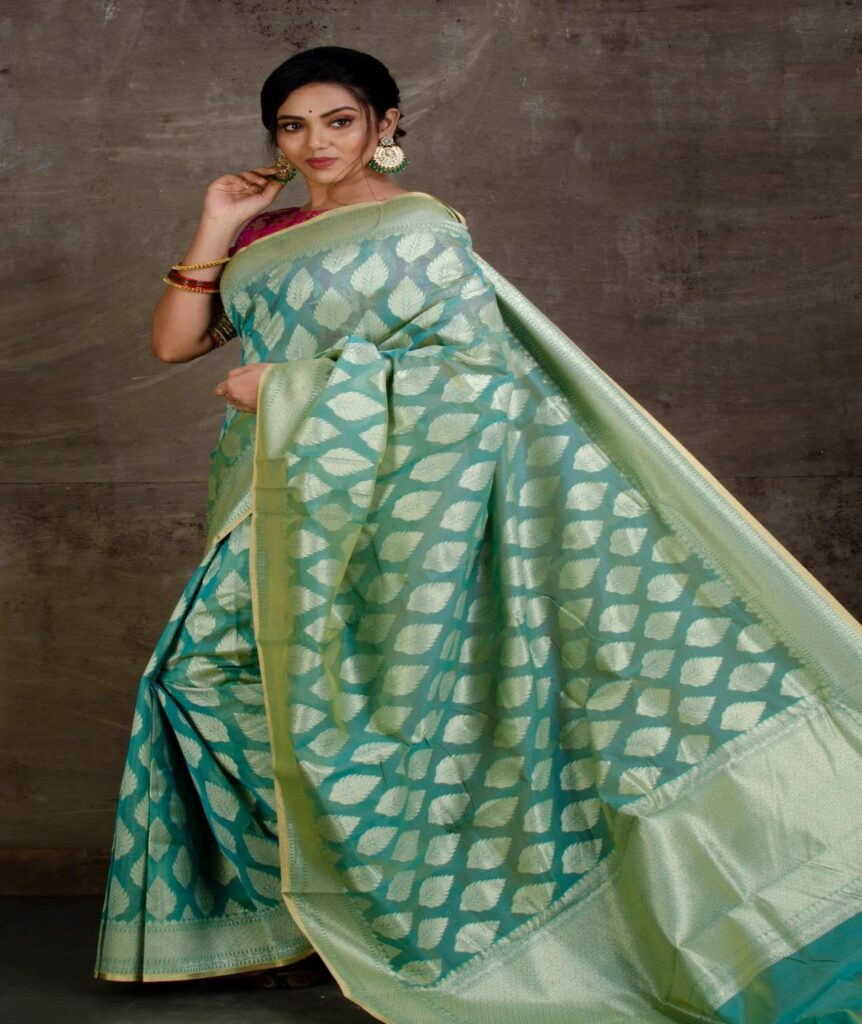

3. Nauvari
Nauvari is one of the types of sarees which is expensive in India
The other very well-known saree of India is Nauvari sarees. If you belong to Maharashtra then definitely must know about this ensemble. Nauvari means, nine yards, which is a very long cloth. Other less known names of Nauvari are Kashta or Lugade sarees. Nauvari sarees are draped in peshvai style. The reason behind wearing these sarees in this way was to remind them of their competency and equality during wars in the patriarchal society.
During festivals you will see a lot of women wearing nauvari. This is believed to bring luck and prosperity in the house.
Initially these were made in cotton fabric but with the time its demand in silk has increased a lot. Mostly you’ll see a thick border on Nauvari with golden embroidery. It is a uniquely draped saree which shows not only the elegance of a woman but also her potential of being not less than anyone.
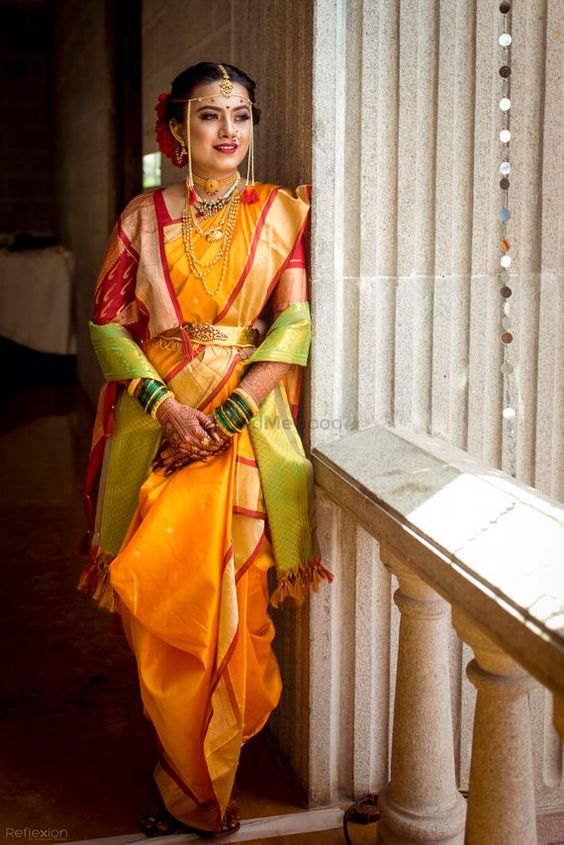

4. Bandhani
Can you imagine some art continuing since 4000 B.C? Yes, Bandhani is that old. There are many Indian monuments which reflects Bandhani art like ‘Ajanta Caves.’
How Bandhani is made? Its simply the other version of ‘tie and dye’ technique. The motifs created on Bandhani are mostly shaped in circles such as ‘dots’ or ‘specks.’ The cloth is picked either by finger-nails or iron nails. The dots on the cloth are used to make many patterns as flowers, bells, animals, creepers and so on.
Bandhani is not just a piece of art it is said to be auspicious and very famous in cities like Rajasthan and Gujarat. Earlier brides used to wear fine Bandhani in their weddings so it was supposed to bring good luck.
Bandhani is used not only in making of different types of sarees but also turbans, dupattas and now-a-days famous designers are also using Bandhani for designer dresses. Wearing a Bandhani is like wearing Indian culture.
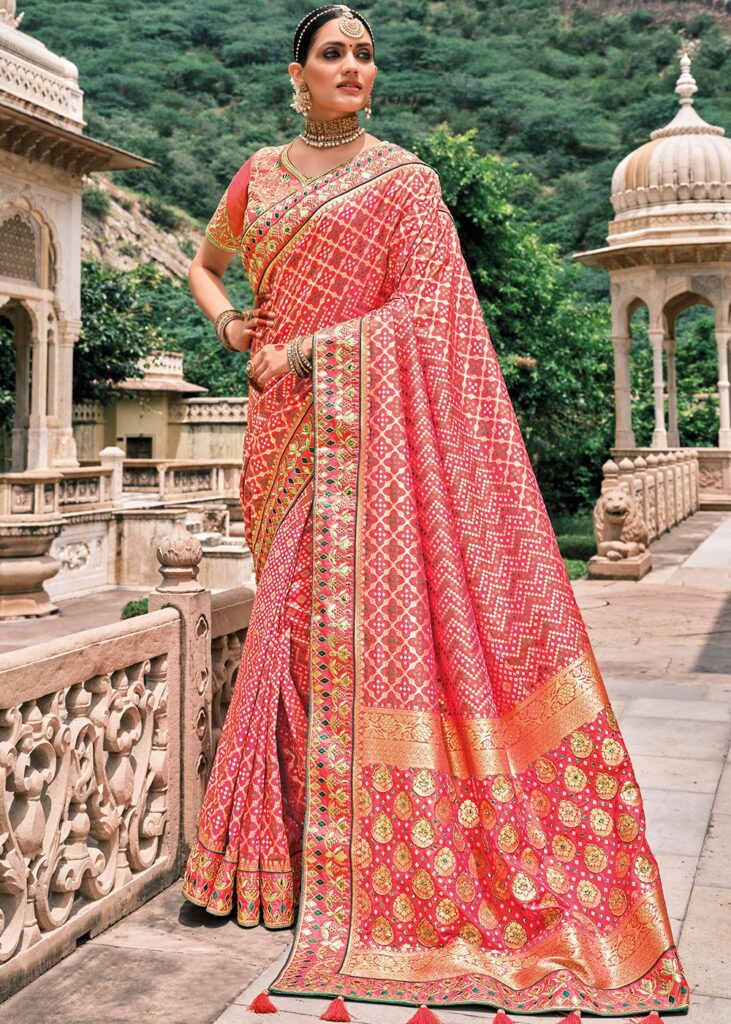

5. Patola
Whenever we talk about Indian cultures, religions or heritage, the digging never stops. It goes to thousands of years. Likewise, Patola is said to be originated 900 years ago.
Patola sarees are very expensive not only because of its designs and intricate work but also for the skill, time and patience given to it. There was a time when Patola sarees were worn only by rich and well-off women.
“Pattakulla” a Sanskrit word originated the name Patola. Warp (vertical) and weft (horizontal) technique is used to weave Patola. To form a pattern the strings are dyed and when its woven the dye marks are aligned which form a pattern. Usually it takes 4-7 months to weave every saree with 3 weavers working on it. So, it has to be expensive. But we have more different types of sarees available in India. Infact surat is most famous for polysters sarees which look same without digging a whole in your pocket. We also have a surat sarees website you can check shaanii
Shades like indigo, henna, turmeric, marigold, these sarees boast.


6. Kanjeevaram
This type of Sari is very famous in south India
Kanchipuram in Tamil Nadu originated Kanjeevaram, having more than 400 years history. Have you ever seen a Kanjeevaram saree? Its literally a masterpiece in itself. The merge of south’s stunning silk and Gujarat’s gold & silver zari makes it a perfect union of fabric. Want to know ‘behind the scene’ making of this fabric? To create the thickness to the cloth, firstly rice water is used to dip the threads, kept under the sun for drying, then silver wire and silk threads are interlocked and finally to complete the weaving golden wires are used. Interesting, right!
Another interesting fact about theses sarees is that the body and pallu of the saree is weaved separately and then combined together afterwards. The reason is their variations of designs and patterns. As these different types of sarees are too expensive so rather than washing at home it’s better to give them for dry-cleaning.
You can check this two beautiful kanjeevaram saree on shaanii. 1. kanchipuram soft silk sarees 2.Maroon and Blue Pallu Silk Saree
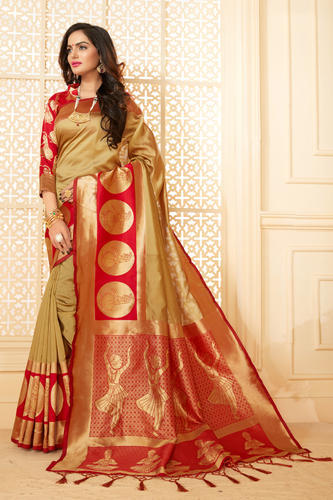

7. Chikankari
My mother-in-law’s mother gave an old saree to her which she transformed into a gown. That saree had chikan work on it and was really beautiful. It was around 25 years old and still looked amazing.
Chikankari is a very delicate thread work. This embroidery style is one of the oldest styles of Lucknow which never goes out of trend. Mehrunissa, wife of Mughal emperor Jahangir, presented this intricate work of art in front of him and pleased him so much that this art got the recognition after that.
The patterns and designs used in Chikankari are taken from Mughal architecture. The fabric is used not only for sarees but also for men’s kurta, pallazos, ladies kurtis, ladies’ suits, etc.
Chikankari is used on many types of cloths like cotton, net, silk, crape, etc.
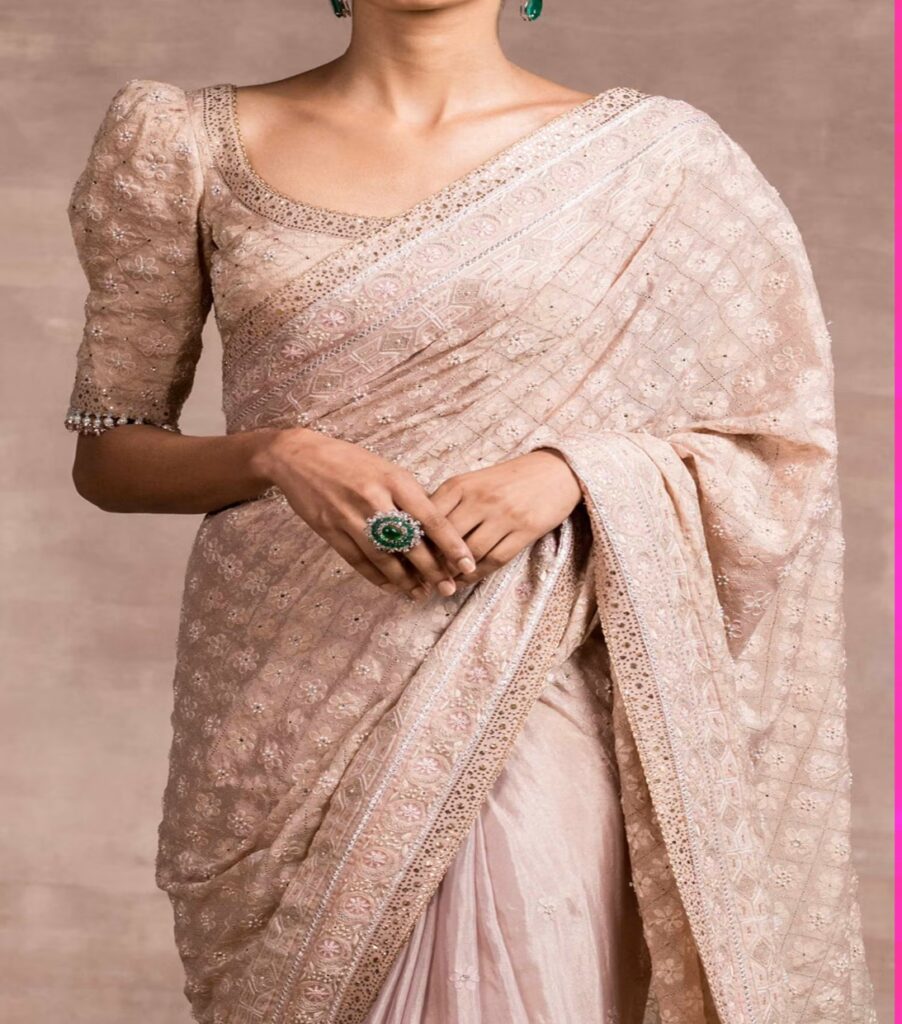

8. Leheriya
Another popular type of fabric where tie and dye technique used is ‘Leheriya.’ Leher means wave and waves are created on the cloth by tie-dye method with the help of nature. Leheriya is a traditional heritage of Rajasthan. Royal class used to wear Leheriya turbans in Rajasthan.
The patterns created on this cloth, be it diagonal or wavy, gives a captivating show of vibrant colours and soothes our eyes. The colours on the cloth show the spirit of Indian Culture. The method basically involves patterns of colour by folding, tying, stitching, crumpling the fabric to inhibit the flow of the dye into the folds of the fabric.
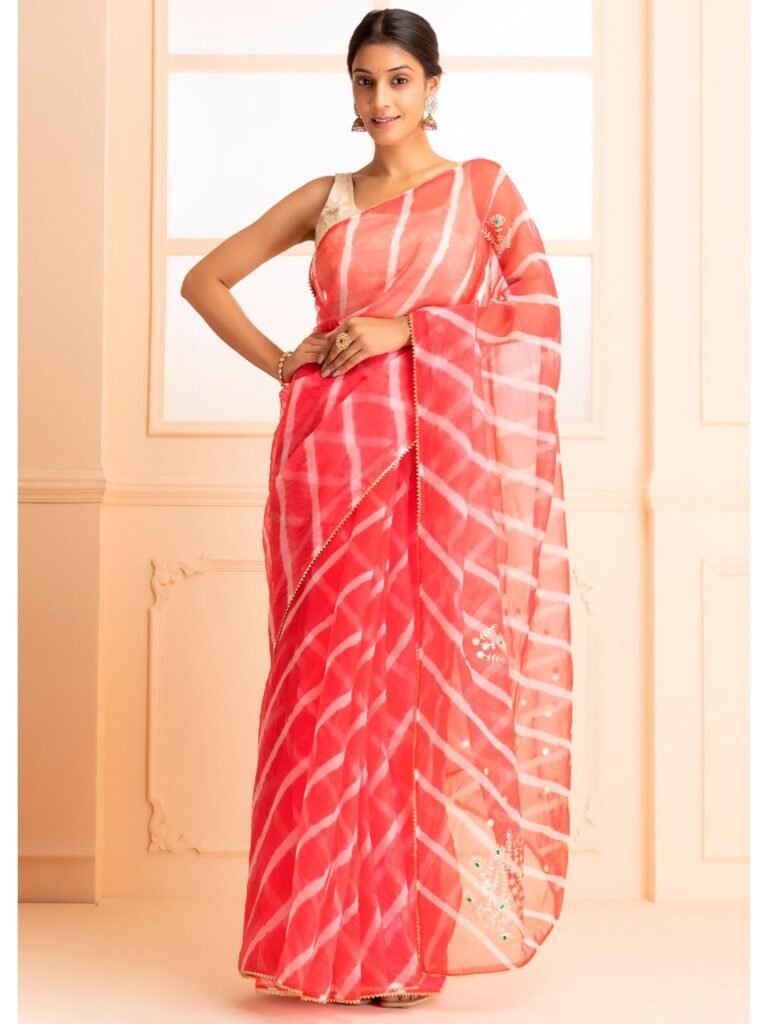

9. Phulkari
India is a country full of art. And Indians have always used this talent for their culture. The world knows how are Indian big fat weddings. But there was a time when things used in weddings were all handmade. Phulkari is one of them. Initially it was not meant for sale rather used only in weddings, functions or births. The patterns and motifs embroidered in phulkari were mostly taken from their own lives. Birds and animals around them, things they ate, different types of flowers were made.
With the passage of time, it gained recognition and was sold in the markets. Phulkari was initiated in Punjab and also called as ‘Folk embroidery of Punjab.’
At first phulkari was used only on Shawls and Odhnis but now it is also used by famous designers on their designer pieces. Imagine a simple art began from householding women from a small city reached to international designers.


India is a colorful country and there are many types of sarees available with a lot of colors and design. You can check our website where we sell a lot of different types of sarees: shaanii